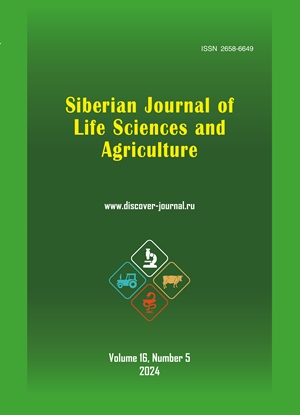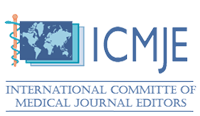МОДИФИКАЦИЯ ЖЕЛАТИНОВЫХ ПЛЕНОК РАСТИТЕЛЬНЫМИ ЭКСТРАКТАМИ
Аннотация
Обоснование. Ценным фармакопейным сырьем для создания лекарственных пленок выступают широко культивируемые растения с известным потенциалом лекарственных свойств. Среди них облепиха крушиновидная (Hippоphaе rhamnоides) и арония черноплодная (Aronia melanocarpa). Включение водных экстрактов из различных структурных частей данных растительных видов в состав лекарственных пленок представляют собой инновационную концепцию трансдермальных терапевтических систем, главным образом, за счет фитохимических компонентов. Кроме того, включением растительных экстрактов в состав лекарственных пленок можно варьировать их эксплуатационные свойства.
Цель. Оценка влияния водных экстрактов из листьев и плодов облепихи крушиновидной, аронии черноплодной на эксплуатационные свойства желатиновых пленок.
Материалы и методы. Измельченное растительное сырье (листья и плоды) подвергали экстрагированию водой в режиме 30 мин – кипящая водяная баня, 15 мин – при комнатной температуре (20±2°С). Экстракты анализировали на предмет содержания в них полифенольных соединений и флавоноидов спектрофотометрическим методом; дубильных веществ – титриметрическим методом; экстрактивных веществ – методом гравиметрии. Пленки получали методом полива из вязкого раствора (10 масс.% желатина марки П-11, 5 масс.% глицерина). Оценивали влияние растительных экстрактов на температурные характеристики, прочность при растяжении и удлинение при разрыве, паропроницаемость, водопоглощение желатиновых пленок. Статистическую обработку результатов измерений проводили согласно ГОСТ Р 8.736-2011.
Результаты. Доказана антиоксидантная способность водных вытяжек из растительного сырья путем определения содержания в них полифенолов, флавоноидов, дубильных веществ. Наиболее высокие значения определяемых показателей установлены для вытяжек из листьев, чем плодов. Технология получения желатиновых пленок обеспечила высвобождение из них фитохимических компонентов. Введение в состав желатиновых пленок растительных экстрактов с большим содержанием экстрактивных веществ повышает удлинение при разрыве; тогда как прочность при растяжении и водопоглощение имели тенденцию к снижению.
Образцы желатиновых пленок с растительными экстрактами являются паропроницаемыми, что обуславливает возможность их использования в качестве трансдермальных терапевтических систем.
Заключение. Введение водных экстрактов из листьев и плодов облепихи крушиновидной, аронии черноплодной в состав желатиновых пленок является эффективным методом улучшения их эксплуатационных свойств.
Скачивания
Литература
Список литературы
Базунова М.В., Чернова В.В., Салихов Р.Б. и др. Физико-химические свойства полимерных композитов на основе полиолефинов и их отходов и лузги подсолнечника // Вестник Башкирского университета. 2018. № 1. С. 70–74. https://doi.org/10.33184/bulletin-bsu-2018.1.13
Браун Д., Флойд А., Сейнсбери М. Органическая спектроскопия. Москва: Мир, 1992. 300 с.
Исупова М.В., Елец А. А., Гребенев И.Р. и др. Количественная оценка полифенольных соединений в водно-спиртовых извлечениях из плодов и листьев // Материалы докладов XI международного симпозиума: Фенольные соединения: фундаментальные и прикладные аспекты. М.: ИФР РАН, 2022. М.: Издательство «Перо», 2022. С. 103.
Кищенко В.М., Верниковский В.В., Привалов И.М., Шевченко А.М. Пленки в Российской медицине и косметологии: история развития, классификация, технология // Фармация и фармакология. 2020. Т. 8, № 2. С. 124–132. https://doi.org/10.19163/2307-9266-2020-8-2-124-132
Ковязина Н.А. Изучение физико-химических свойств пленок лекарственных секстафаг // Вестник ВГУ, серия: химия, биология, фармация. 2022. № 1. С. 78–84.
Лосенкова С.О., Тюнина Е.Д., Павлюченкова Н.А. и др. Современный ассортимент трансдермальных лекарственных форм на фармацевтическом рынке России // Вестник Смоленской государственной медицинской академии. 2022. Т. 21, № 1. С. 152–159. https://doi.org/10.37903/vsgma.2022.1.20
Мяленко Д.М., Михайленко П.Г. Исследование краевого угла смачивания полиэтиленовой пленки, модифицированной органическими и неорганическими компонентами // Международный научно-исследовательский журнал. 2020. № 12 (102). Ч. 1. С. 49–53. https://doi.org/10.23670/IRJ.2020.102.12.009
Платонова Е.Ю., Плюснин С.Н., Шапошников М.В., Москалев А.А. Арония черноплодная (Aronia melanocarpa) как источник соединений с потенциальной геропротекторной активностью // Вестник Института биологии Коми НЦ УрО РАН. 2019. № 2 (209). С. 2–9. https://doi.org/10.31140/j.vestnikib.2019.2(209).1
Преч Э., Бульманн Ф., Аффольтер К. Определение структуры органических соединений. Москва: Мир, 2006. 438 с.
Шлейкин А.Г., Шаталов И.С., Шаталова А.С. Влияние трансглутаминазы на механические характеристики упаковочного материала на основе желатина // Научный журнал НИУ ИТМО. Серия «Процессы и аппараты пищевых производств». 2014. № 2. 5 с.
Ямпольская Г.П., Тарасевич Б.Н., Еленский А.А. Вторичная структура глобулярных белков в адсорбционных слоях на границе фаз раствор-воздух по данным ИК-спектроскопии Фурье // Коллоидный журнал. 2005. Т. 67, № 3. С. 426–432.
Ahmad U., Ahmad R.S. Antidiabetic properties of aqueous extract of Stevia rebaudiana Bertoni leaves on streptozotocin-induced diabetes in albino rats // Complementary and Alternative Medicine BMC, 2018, vol. 18, no. 1, pp. 1–11. https://doi.org/10.1186/s12906-018-2245-2
Amjadi S., Emaminia S., Heyat Davudian Sh. et al. Preparation and characterization of gelatin-based nanocomposite containing chitosan nanofiber and ZnO nanoparticles // Carbohydrate Polymers, 2019, vol. 216, рр. 376–384. https://doi.org/10.1016/j.carbpol.2019.03.062
Andrighetti T.T., Jacques M.C., Schmitt C. et al. Polymeric pullulan films incorporated with extract of Cyclospermum leptophyllum (pers.) Sprague for healing purposes // Research, Society and Development, [S. l.], 2022, vol. 11, no. 15, pp. e209111537082. https://doi.org/10.33448/rsd-v11i15.37082
Antosik A.K., Miądlicki P., Wilpiszewska K. et al. Polysaccharide films modified by compounds of natural origin and silver having potential medical applications // Cellulose, 2021, vol. 28(6), pp. 7257–7271. https://doi.org/10.1007/s10570-021-04008-0
Cerqueira M.A., Souza B.W., Teixeira, J.A., Vicente A.A. Effect of glycerol and corn oil on physicochemical properties of polysaccharide films: a comparative study // Food Hydrocolloids, 2012, vol. 27(1), pp. 175–184. https://doi.org/10.1016/j.foodhyd.2011.07.007
Contardi M., Ayyoub A. M. M., Summa M. Self-Adhesive and Antioxidant Poly(vinylpyrrolidone)/Alginate-Based Bilayer Films Loaded with Malva sylvestris Extracts as Potential Skin Dressings // ACS Applied Bio Materials, 2022, vol. 5(6), pp. 2880–2893. https://doi.org/10.1021/acsabm.2c00254
Costa N.N., Lopes L.F., Ferreira D.F. Polymeric films containing pomegranate peel extract based on PVA/starch/PAA blends for use as wound dressing: In vitro analysis and physicochemical evaluation // Materials Science and Engineering: C, 2020, vol. 109, art. 110643. https://doi.org/10.1016/j.msec.2020.110643
Donato P.D., Taurisano V., Poli A. et al. Vegetable wastes derived polysaccharides as natural eco-friendly plasticizers of sodium alginate // Carbohydrate Polymers, 2020, vol. 229, art. 115427. https://doi.org/10.1016/j.carbpol.2019.115427
Dudonné S., Vitrac X., Coutière P. Comparative Study of Antioxidant Properties and Total Phenolic Content of 30 Plant Extracts of Industrial Interest Using DPPH, ABTS, FRAP, SOD, and ORAC Assays // Journal of Agricultural and Food Chemistry, 2009, vol. 57(5), pp. 1768–1774. https://doi.org/10.1021/jf803011r
Guimarães I., Baptista-Silva S., Pintado M. Oliveira L. A. Polyphenols: A Promising Avenue in Therapeutic Solutions for Wound Care // Applied Sciences, 2021, vol. 11(3), 1230. https://doi.org/10.3390/app11031230
Ji M., Gong X., Li X. Advanced Research on the Antioxidant Activity and Mechanism of Polyphenols from Hippophae Species – A Review // Molecules, 2020, vol. 25(4), 917. https://doi.org/10.3390/molecules25040917
Li K., Jin Sh., Chen H., Li J. Bioinspired interface engineering of gelatin/cellulose nanofibrils nanocomposites with high mechanical performance and antibacterial properties for active packaging // Composites Part B: Engineering, 2019, vol. 171, pp. 222–234. https://doi.org/10.1016/j.compositesb.2019.04.043
Luo M., Cao Y., Wang W. et al. Sustained-release antimicrobial gelatin film: effect of chia mucilage on physicochemical and antimicrobial properties // Food Hydrocolloids, 2019, vol. 87, pp. 783–791. https://doi.org/10.1016/j.foodhyd.2018.09.010
Minna L., Yong C., Wenbo W. et al. Sustained-release antimicrobial gelatin film: effect of chia mucilage on physicochemical and antimicrobial properties // Food Hydrocolloids, 2019, vol. 87, pp. 783–791. https://doi.org/10.1016/j.foodhyd.2018.09.010
Nilsuwan K., Benjakul S., Prodpran T. Properties and antioxidative activity of fish gelatin-based film incorporated with epigallocatechin gallate // Food Hydrocolloids, 2018, vol. 80, pp. 212–221. https://doi.org/10.1016/j.foodhyd.2018.01.033
Sabbagh F., Kim B.S. Recent advances in polymeric transdermal drug delivery systems // Journal of Controlled Release, 2022, vol. 341, рр. 132–146. https://doi.org/10.1016/j.jconrel.2021.11.025
Shankar S., Teng X., Li G., Rhim J.W. Preparation, characterization, and antimicrobial activity of gelatin/ZnO nanocomposite films // Food Hydrocolloids, 2015, vol. 45, pp. 264–271. https://doi.org/10.1016/j.foodhyd.2014.12.001
Suderman N., Isa M.I.N., Sarbon N.M. The effect of plasticizers on the functional properties of biodegradable gelatin-based film: A review // Food Bioscience, 2018, vol. 24, pp. 111–119. https://doi.org/10.1016/j.fbio.2018.06.006
Sutar T., Bangde P., Dandekar P., Adivarekar R. Fabrication of Herbal Hemostat Films Loaded with Medicinal Tridax Procumbenns Extracts // Fibers and Polymers, 2021, vol. 22, no. 8, pp. 2135–2144. https://doi.org/10.1007/s12221-021-0808-1
Taheri P., Jahanmardi R., Koosha M., Abdi S. Physical, mechanical and wound healing properties of chitosan/gelatin blend films containing tannic acid and/or bacterial nanocellulose // International Journal of Biological Macromolecules, 2020, vol. 154, pp. 421–432. https://doi.org/10.1016/j.ijbiomac.2020.03.114
Takó M., Kerekes E.B., Zambrano C. et al. Plant Phenolics and Phenolic-Enriched Extracts as Antimicrobial Agents against Food-Contaminating Microorganisms // Antioxidants, 2020, vol. 9(2):165. https://doi.org/10.3390/antiox9020165
Zagoskina N.V., Zubova M.Y., Nechaeva T.L. et al. Polyphenols in Plants: Structure, Biosynthesis, Abiotic Stress Regulation, and Practical Applications (Review) // International Journal of Molecular Sciences, 2023; 24(18): 13874. https://doi.org/10.3390/ijms241813874
References
Bazunova M.V., Chernova V.V., Salikhov R.B. et al. Physico-chemical properties of polymer composites based on polyolefins and their waste and sunflower husks. Vestnik Bashkirskogo universiteta, 2018, no. 1, pp. 70–74. https://doi.org/10.33184/bulletin-bsu-2018.1.13
Brown D., Floyd A., Sainsbury M. Organic spectroscopy. Moscow: Mir, 1992, 300 p.
Isupova M.V., Elets A.A., Grebenev I.R. et al. Quantitative assessment of polyphenolic compounds in aqueous-alcoholic extracts from fruits and leaves. Materialy dokladov XI mezhdunarodnogo simpoziuma: Phenolic compounds: fundamental and applied aspects. М.: IFR RAN; Pero, 2022, p. 103.
Kishchenko V.M., Vernikovsky V.V., Privalov I.M., Shevchenko A.M. Films in Russian medicine and cosmetology: development history, classification, technology. Pharmacy & Pharmacology, 2020, vol. 8(2), pp. 124-132. https://doi.org/10.19163/2307-9266-2020-8-2-124-132
Kovyazina N.A. Study of the physicochemical properties of medicinal sextaphage films. Vestnik VGU, seriya: khimiya, biologiya, farmatsiya, 2022, no. 1, pp. 78–84.
Losenkova S.O., Tyunina E.D., Pavlyuchenkova N.A. etc. Modern range of transdermal dosage forms on the Russian pharmaceutical market. Vestnik Smolenskoy gosudarstvennoy meditsinskoy akademii, 2022, vol. 21, no. 1, pp. 152–159. https://doi.org/10.37903/vsgma.2022.1.20
Myalenko D.M., Mikhailenko P.G. Study of the contact angle of polyethylene film modified with organic and inorganic components. Mezhdunarodnyy nauchno-issledovatelskiy zhurnal, 2020, no. 12 (102), part 1, pp. 49–53. https://doi.org/10.23670/IRJ.2020.102.12.009
Platonova E.Yu., Plyusnin S.N., Shaposhnikov M.V., Moskalev A.A. Aronia melanocarpa as a source of compounds with potential geroprotective activity. Vestnik Instituta biologii Komi NTs UrO RAN, 2019, no. 2 (209), pp. 2–9. https://doi.org/10.31140/j.vestnikib.2019.2(209).1
Pretsch E., Bulmann F., Affolter K. Structure determination of organic compounds. Moscow: Mir, 2006, 438 p.
Shleikin A.G., Shatalov I.S., Shatalova A.S. Effect of transglutaminase on the mechanical characteristics of gelatin-based packaging material. Nauchnyy zhurnal NIU ITMO. Seriya «Protsessy i apparaty pishchevykh proizvodstv», 2014, no. 2, 5 р.
Yampolskaya G.P., Tarasevich B.N., Elenskiy A.A. Secondary Structure of Globular Proteins in Adsorption Layers at the Solution-Air Phase Boundary According to Fourier Transform IR Spectroscopy Data. Colloid Journal, 2005, vol. 67, no. 3, pp. 426–432.
Ahmad U., Ahmad R.S. Antidiabetic properties of aqueous extract of Stevia rebaudiana Bertoni leaves on streptozotocin-induced diabetes in albino rats. Complementary and Alternative Medicine BMC, 2018, vol. 18, no. 1, pp. 1–11. https://doi.org/10.1186/s12906-018-2245-2
Amjadi S., Emaminia S., Heyat Davudian Sh. et al. Preparation and characterization of gelatin-based nanocomposite containing chitosan nanofiber and ZnO nanoparticles. Carbohydrate Polymers, 2019, vol. 216, pp. 376–384. https://doi.org/10.1016/j.carbpol.2019.03.062
Andrighetti T.T., Jacques M.C., Schmitt C. et al. Polymeric pullulan films incorporated with extract of Cyclospermum leptophyllum (pers.) Sprague for healing purposes. Research, Society and Development, [S. l.], 2022, vol. 11, no. 15, pp. e209111537082. https://doi.org/10.33448/rsd-v11i15.37082
Antosik A.K., Miądlicki P., Wilpiszewska K. et al. Polysaccharide films modified by compounds of natural origin and silver having potential medical applications. Cellulose, 2021, vol. 28(6), pp. 7257–7271. https://doi.org/10.1007/s10570-021-04008-0
Cerqueira M.A., Souza B.W., Teixeira, J.A., Vicente A.A. Effect of glycerol and corn oil on physicochemical properties of polysaccharide films: a comparative study. Food Hydrocolloids, 2012, vol. 27(1), pp. 175–184. https://doi.org/10.1016/j.foodhyd.2011.07.007
Contardi M., Ayyoub A. M. M., Summa M. Self-Adhesive and Antioxidant Poly(vinylpyrrolidone)/Alginate-Based Bilayer Films Loaded with Malva sylvestris Extracts as Potential Skin Dressings. ACS Applied Bio Materials, 2022, vol. 5(6), pp. 2880–2893. https://doi.org/10.1021/acsabm.2c00254
Costa N.N., Lopes L.F., Ferreira D.F. Polymeric films containing pomegranate peel extract based on PVA/starch/PAA blends for use as wound dressing: In vitro analysis and physicochemical evaluation. Materials Science and Engineering: C, 2020, vol. 109, art. 110643. https://doi.org/10.1016/j.msec.2020.110643
Donato P.D., Taurisano V., Poli A. et al. Vegetable wastes derived polysaccharides as natural eco-friendly plasticizers of sodium alginate. Carbohydrate Polymers, 2020, vol. 229, art. 115427. https://doi.org/10.1016/j.carbpol.2019.115427
Dudonné S., Vitrac X., Coutière P. Comparative Study of Antioxidant Properties and Total Phenolic Content of 30 Plant Extracts of Industrial Interest Using DPPH, ABTS, FRAP, SOD, and ORAC Assays. Journal of Agricultural and Food Chemistry, 2009, vol. 57(5), pp. 1768–1774. https://doi.org/10.1021/jf803011r
Guimarães I., Baptista-Silva S., Pintado M. Oliveira L. A. Polyphenols: A Promising Avenue in Therapeutic Solutions for Wound Care. Applied Sciences, 2021, vol. 11(3), 1230. https://doi.org/10.3390/app11031230
Ji M., Gong X., Li X. Advanced Research on the Antioxidant Activity and Mechanism of Polyphenols from Hippophae Species – A Review. Molecules, 2020, vol. 25(4), 917. https://doi.org/10.3390/molecules25040917
Li K., Jin Sh., Chen H., Li J. Bioinspired interface engineering of gelatin/cellulose nanofibrils nanocomposites with high mechanical performance and antibacterial properties for active packaging. Composites Part B: Engineering, 2019, vol. 171, pp. 222–234. https://doi.org/10.1016/j.compositesb.2019.04.043
Luo M., Cao Y., Wang W. et al. Sustained-release antimicrobial gelatin film: effect of chia mucilage on physicochemical and antimicrobial properties. Food Hydrocolloids, 2019, vol. 87, pp. 783–791. https://doi.org/10.1016/j.foodhyd.2018.09.010
Minna L., Yong C., Wenbo W. et al. Sustained-release antimicrobial gelatin film: effect of chia mucilage on physicochemical and antimicrobial properties. Food Hydrocolloids, 2019, vol. 87, pp. 783–791. https://doi.org/10.1016/j.foodhyd.2018.09.010
Nilsuwan K., Benjakul S., Prodpran T. Properties and antioxidative activity of fish gelatin-based film incorporated with epigallocatechin gallate. Food Hydrocolloids, 2018, vol. 80, pp. 212–221. https://doi.org/10.1016/j.foodhyd.2018.01.033
Sabbagh F., Kim B.S. Recent advances in polymeric transdermal drug delivery systems. Journal of Controlled Release, 2022, vol. 341, рр. 132–146. https://doi.org/10.1016/j.jconrel.2021.11.025
Shankar S., Teng X., Li G., Rhim J.W. Preparation, characterization, and antimicrobial activity of gelatin/ZnO nanocomposite films. Food Hydrocolloids, 2015, vol. 45, pp. 264–271. https://doi.org/10.1016/j.foodhyd.2014.12.001
Suderman N., Isa M.I.N., Sarbon N.M. The effect of plasticizers on the functional properties of biodegradable gelatin-based film: A review. Food Bioscience, 2018, vol. 24, pp. 111–119. https://doi.org/10.1016/j.fbio.2018.06.006
Sutar T., Bangde P., Dandekar P., Adivarekar R. Fabrication of Herbal Hemostat Films Loaded with Medicinal Tridax Procumbenns Extracts. Fibers and Polymers, 2021, vol. 22, no. 8, pp. 2135–2144. https://doi.org/10.1007/s12221-021-0808-1
Taheri P., Jahanmardi R., Koosha M., Abdi S. Physical, mechanical and wound healing properties of chitosan/gelatin blend films containing tannic acid and/or bacterial nanocellulose. International Journal of Biological Macromolecules, 2020, vol. 154, pp. 421–432. https://doi.org/10.1016/j.ijbiomac.2020.03.114
Takó M., Kerekes E.B., Zambrano C. et al. Plant Phenolics and Phenolic-Enriched Extracts as Antimicrobial Agents against Food-Contaminating Microorganisms. Antioxidants, 2020, vol. 9(2):165. https://doi.org/10.3390/antiox9020165
Zagoskina N.V., Zubova M.Y., Nechaeva T.L. et al. Polyphenols in Plants: Structure, Biosynthesis, Abiotic Stress Regulation, and Practical Applications (Review). International Journal of Molecular Sciences, 2023, vol. 24(18), 13874. https://doi.org/10.3390/ijms241813874
Просмотров аннотации: 64 Загрузок PDF: 37
Copyright (c) 2024 Evgenia V. Tovstik, Evgeniya S. Shirokova

Это произведение доступно по лицензии Creative Commons «Attribution-NonCommercial-NoDerivatives» («Атрибуция — Некоммерческое использование — Без производных произведений») 4.0 Всемирная.






















































